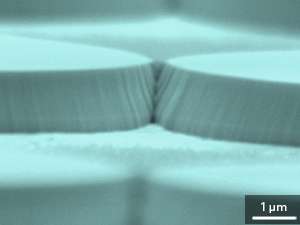Microstructures made of adjoining semiconductor disks could lead to powerful nanoscale sensors

Many users of microwave ovens have had the frightening experience of leaving a fork, crumpled piece of aluminum foil or some other pointy metal item inside the cooking chamber. The sharp metal object acts as an antenna for the oven's microwave radiation, causing strong local heating or sparking. Jing Hua Teng from the A*STAR Institute of Materials Research and Engineering (IMRE) and colleagues in Singapore and the UK have now observed a similar antenna effect, involving a different sort of electromagnetic radiation—known as terahertz (THz) radiation—in a microfabricated semiconductor structure. Their discovery could find application in areas ranging from biosensing to airport security scanners.
Teng and his co-workers developed tiny semiconductor structures made of the chemical elements indium and antimony. From this material, they produced disks of 20 micrometers in diameter, which they arranged such that pairs just touched. The gap between contiguous disks was merely tens to hundreds of nanometers wide (see image). When the researchers exposed the structures to THz radiation, they found that the radiation intensity in the gap was enhanced by more than a hundred times.
Confining and enhancing THz radiation is significant for two reasons, according to Teng. First, electromagnetic waves in the THz range can be used in a broad range of applications, for example, to study the structure of large biomolecules. As this sort of radiation can penetrate textiles but is less energetic than X-rays—or microwaves—it is also well suited for use in body scanners at airports. The second reason as to why the new results are important is more fundamental. "We have produced this particular touching-disk structure to test, in the THz regime, intriguing theoretical predictions made for optical radiation," explains Teng. "Building a device such as ours for visible light is much more challenging, as it would involve even smaller structures."
The now-verified theoretical predictions came from collaborators at Imperial College London in the UK. "For the present work, IMRE is in charge of the materials growth and the structure fabrication, while Imperial College contributes structure design and characterization," says Teng. The A*STAR researchers are now focused on practical applications: they will further explore the unique properties of their semiconductor materials and try to develop devices for THz technology. The group has already succeeded in tuning the THz response of their structure, meaning that they can conveniently adjust the frequency response of their device for different applications.
More information: Hanham, S. et al. Broadband terahertz plasmonic response of touching InSb disks. Advanced Materials 24, OP226–OP230 (2012). onlinelibrary.wiley.com/doi/10 … a.201202003/abstract
Deng, L. et al. Direct optical tuning of the terahertz plasmonic response of InSb subwavelength gratings. Advanced Optical Materials 1, 128–132 (2013). onlinelibrary.wiley.com/doi/10 … m.201200032/abstract
Journal information: Advanced Materials
















